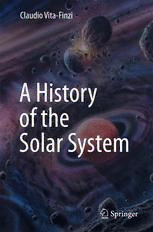
A History of the Solar System PDF
Preview A History of the Solar System
Claudio Vita-Finzi A History of the Solar System A History of the Solar System The Oort Cloud, a hypothetical spherical reservoir at 103–105 AU, contains 1011 to perhaps 1012 comets; the disk-like Kuiper Belt, at 30–1000 AU, contains 108–109 comets; the asteroid belt contains 109–1012 asteroids Claudio Vita-Finzi A History of the Solar System 1 3 Claudio Vita-Finzi Department of Earth Sciences Natural History Museum London UK ISBN 978-3-319-33848-4 ISBN 978-3-319-33850-7 (eBook) DOI 10.1007/978-3-319-33850-7 Library of Congress Control Number: 2016941089 © Springer International Publishing Switzerland 2016 This work is subject to copyright. All rights are reserved by the Publisher, whether the whole or part of the material is concerned, specifically the rights of translation, reprinting, reuse of illustrations, recitation, broadcasting, reproduction on microfilms or in any other physical way, and transmission or information storage and retrieval, electronic adaptation, computer software, or by similar or dissimilar methodology now known or hereafter developed. The use of general descriptive names, registered names, trademarks, service marks, etc. in this publication does not imply, even in the absence of a specific statement, that such names are exempt from the relevant protective laws and regulations and therefore free for general use. The publisher, the authors and the editors are safe to assume that the advice and information in this book are believed to be true and accurate at the date of publication. Neither the publisher nor the authors or the editors give a warranty, express or implied, with respect to the material contained herein or for any errors or omissions that may have been made. Cover artwork © Don Dixon/cosmographica.com Printed on acid-free paper This Springer imprint is published by Springer Nature The registered company is Springer International Publishing AG Switzerland Damn the Solar System! bad light—planets too distant—pestered with comets—feeble contrivance; —could make a better with great ease Lord Francis Jeffrey (1773–1850) according to the Rev. Sydney Smith For Alexandre Preface As we move with ever greater confidence between the planets, their moons, a few comets and asteroids, and some grains of dust, and prepare to enter interstellar space almost 20 billion km from Earth after a journey of 36 years at 61,000 km/hr, it seems a good moment to consider the history of the only planetary system we are currently capable of exploring in any detail. But the discovery of over two thousand planets which are orbiting stars other than our own Sun will undoubtedly spur humanity before long to find ways of visiting those alien worlds in one way or another. This short book outlines a story which spans 4.5 billion years and which is the fruit of a few millennia of naked eye observation, four centuries of squinting through telescopes, and sixty years informed by orbiting satellites and manned and unmanned probes and landers, profound laboratory studies, and imaginative hypotheses. My principal aim is to link events dating back billions of years which we can glimpse among the stars with our everyday concerns on Earth and to demonstrate that the solar system continues to evolve and diversify. Although the chapters are broadly in chronological order, I have tried to get away from the ‘one era after another’ scheme by devoting successive chapters to a brief history of ideas about the solar system; the raw materials of which the solar system is constructed; their assembly into solid, gaseous, and icy bodies; the evolution of the solar system’s key player, the Sun; the major changes undergone by the planets and moons after they had formed; the emergence of life; and some of the current changes that help us understand the solar system’s past. Some of the material is difficult but so is the subject matter, and the drift will usually be clear from the context. Above all, I hope to have conveyed the excitement and wonder that comes from looking up—at the sky and in the library. Every one of these themes draws on advances in geochemistry, biology, and computing as much as to targeted space missions and ground-based observa- tion, and to the work of individuals, teams, and space agencies, in particular the ever generous NASA, debts I try to acknowledge in the references and captions. ix x Preface I am grateful to Paul Henderson and his successors in London’s Natural History Museum for h ospitality, to Mark Biddiss, Ken Blyth, Louis Butler, Ian Crawford, Dominic Fortes, Kenneth Phillips, Michael Russell, Sara Russell, Fred Taylor, Leo Vita-Finzi, and Michael Woolfson for their searching but kindly comments on parts of the text; to Simon Tapper for help with the figures; to Don Dixon for the cover image; and to Petra van Steenbergen and Hermine Vloemans at Springer for support. Ferrara, March 2016 Claudio Vita-Finzi Note: Myr is used throughout for million (106) years and Gyr for billion (giga,109) years Contents 1 Introduction ................................................ 1 References .................................................. 10 2 Raw Materials .............................................. 13 Gas ...................................................... 14 Dust ...................................................... 16 Ices ...................................................... 17 CAIs and Chondrules ......................................... 20 PAHs ...................................................... 24 References .................................................. 24 3 Assembly .................................................. 27 Accretion ................................................... 29 Satellites and Rings ........................................... 33 References .................................................. 36 4 The Solar Nucleus ........................................... 39 Gravity ..................................................... 42 The Heliosphere ............................................. 45 References .................................................. 47 5 Differentiation .............................................. 49 Mineral Evolution ............................................ 54 Atmospheres and Oceans ...................................... 55 References .................................................. 58 6 Operation .................................................. 61 The Stability of our Solar System ................................ 62 Orbits, Tides and Impacts ...................................... 66 References .................................................. 69 xi
